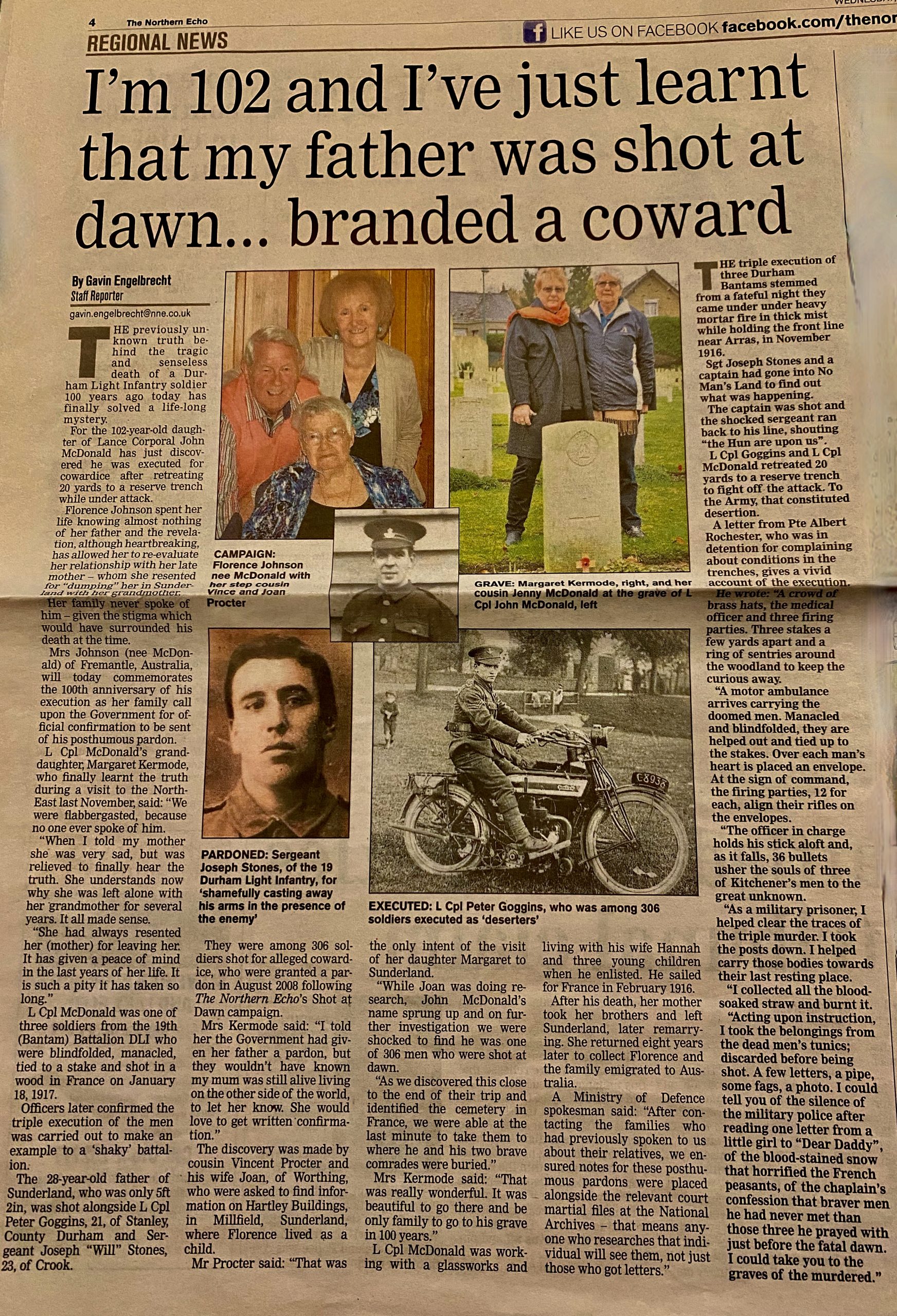The Soldier's Details

- Surname:
- MacDonald
- First Name:
- John
- Nick Name:
- Jack
- Rank:
- Private
- Regimental #:
- WX224
- Classification:
- Mechanic
- Company:
- ‘D’ Company Headquarters transferred to No. 15 Platoon
- Enlisted:
- 11.12.1940
- DOB:
- 11.05.1912
- Place of Birth:
- Sunderland, England
- Father's Name:
- John MacDonald
- Mothers's Name:
- Hannah MacDonald/Diggle (nee Cavanagh)
- Religion:
- Roman Catholic
- Pre-war Occupation:
- Truck Driver
- Memorial:
- Epitaph, Singapore Memorial, Column 136, Age 29.
- Cause of Death:
- Missing believed killed in action
- Place of Death:
- Near Ama Keng Village
- Date of Death:
- 9.02.1942
General Description
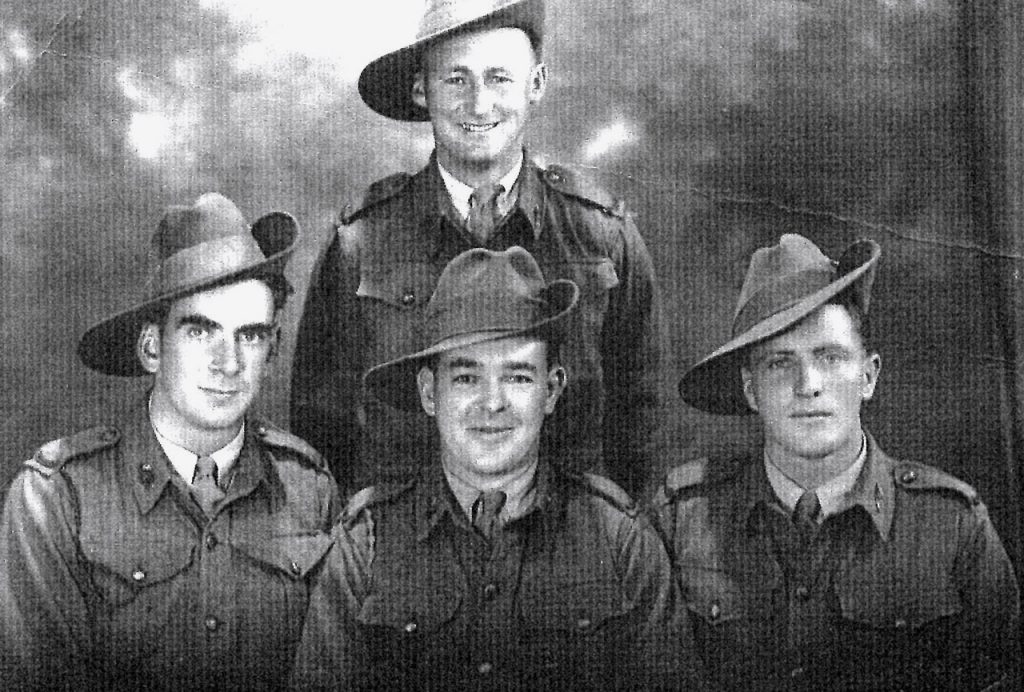
The above photograph – believed to be Drivers (& Mechanics) who undertook Training. On right is believed to be Albert Facey KIA 15 Feb 1942.
MacDonald’s family were not able to be notified of John’s confirmed death until several months after war ended, in fact it was April 1946. Jack had been KIA on the first day of fighting. Four years later War Graves were challenged to locate and and identify soldiers.
We believe Jack was working at Morowa when he enlisted.
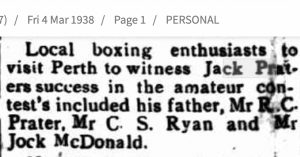
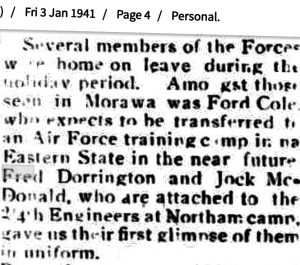
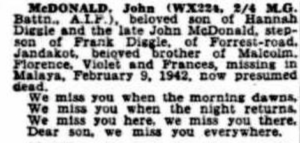
April 1946.
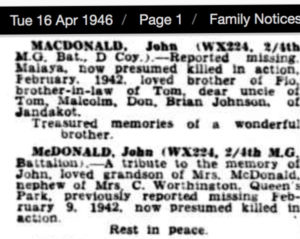
McDonald enlisted AIF 11 Dec 1940 later joining 2/4th MGB’s ‘D’ Company Headquarters, later transferring to No.15 Platoon at Singapore. Please read further.
John MacDonald with WX9393 Lt. John Meiklejohn, CO of No. 15 Platoon, D Company, WX7127 Sgt John Solly, Platoon Sgt and others were missing the night of 8 February – they were reported KIA fighting their way out from the west coast of Singapore during early morning. MacDonald was KIA near Ama Keng village on 9 February 1942. Meiklejohn and Solly were also KIA.
John was born Sunderland, England the second child to parents John MacDonald (Snr) and Hannah MacDonald. John had an older brother Malcolm born in March 1910 and sister Florence born October 1914.
John MacDonald (jnr), his mother, stepfather and family sailed to Fremantle and WA from England in 1928 – he would have been about 16 years old.
He enlisted AIF 11 Dec 1940 and underwent further training as a mechanic and was classified T/G III.
He was a driver before enlistment. John had earlier joined the Militia MTD, his No. 235609.
As soon as 10th Light Horse Militia broke camp, the next lot of militia units were ready to move in. On 12 April 1940 the 3rd Field Brigade, Royal Australian Artillery and Workshop Company of 5th Australian Army Ordnance Corps arrived to begin their three months’ training.
Below: The Militia Camp at Naval Base (Rockingham area).
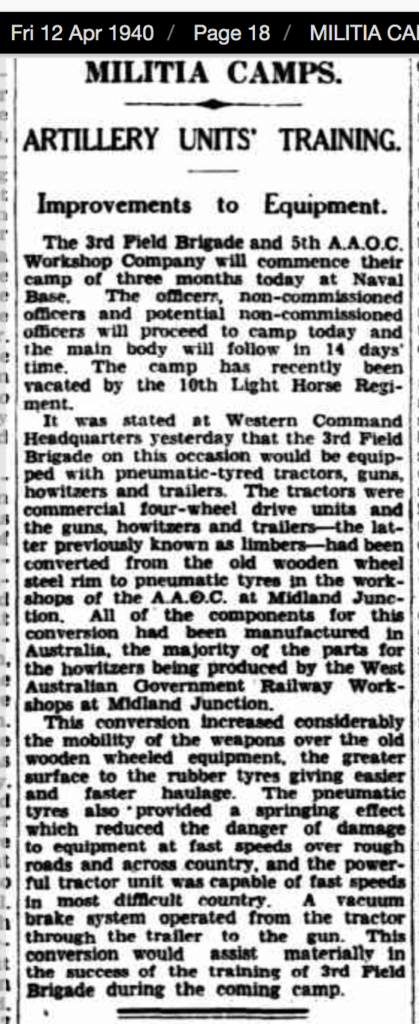
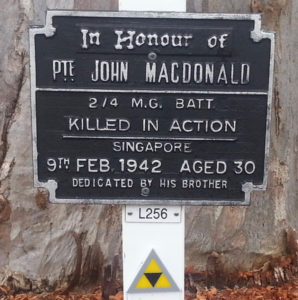
Above plaque was arranged by John’s brother for Kings Park Honour Avenue.
Biography abstract:
‘Private John MacDonald, service number WX224 of 2/4 Machine Gun Battalion, was killed in action in Singapore on 9 February 1942. He was 30 years of age.
His plaque is placed alongside Private Maurice Lester Browne, who was in the same 2/4 Machine Gun Battalion and died on the same day.’
__________
We believe John MacDonald (jnr) had no knowledge of his father’s death in WW1. The event and what the family went through after would have been so truamatic and so public, we believe his mother did not inform her children.
From the death notices we are able to ascertain, John MacDonald (Snr’s) mother also moved to WA with Hannah Diggie (previously MacDonald) and her children. Mrs C Worthington would have been John MacDonald’s (Snr) sister. The whole family would have endured finger-pointing as this is what the British Government set out to do – to make a point about these soldiers and John MacDonald who supposedly disobeyed orders. Britain and her Allies were then losing thousands of men on the battlefields. ‘Better to lay the blames at somebody’s feet other than the Generals who made such poor decisions.’
___________
John MacDonald Snr. enlisted WW1 joining Durham 19th Battalion Light Infantry. This was in fact a Bantam Battalion – the British Army had a minimum height intake of 5’3″. He had attempted to enlist earlier but was informed he was too short.
There were large numbers of men under 5’3″ who volunteered. The numbers overwhelmed the recruiting centres. One of these men was John McDonald who was 5’2″. (John MacDonald Jnr was 5’3″). Thousands of would-enlistments were turned away. Firstly Britain had too many men wishing to enlist, resulting in an introduction of a height restriction to deter numbers. In September 1914, the army had introduced a height restriction from 5’3″ to 5’6″. The numbers of would-be enlistments dropped; the height was lowered to 5’4″ by October 1914 and then to 5’3″ by November1914.
By July 1915 the minimum height was 5’2″.
It was never envisaged the war would last as long as it did. England realised they needed more men. The slaughter of soldiers in France was horrendous – but the incompetency of leading British officers was worse. WW1 exposed class war at its worse. It didn’t seem to matter how many soldiers were killed in battle on any one day, because those in charge believed they could call on more numbers to take their places anytime and anywhere. For Germany it was much the same! The deaths of ‘foot soldiers’ was done by numbers, not names.
Initially the War Office accepted 3,000 men who had previously been barred from enlistment, forming two Birkenhead Bantam Battalions. John MacDonald Snr enlisted.
By the end of WW1, 29 Bantam battalions had been formed across three divisions, two British and one Canadian. With about 1,000 men in each battalion, including replacements this figure is estimated at a total of roughly 30,000 Bantam Soldiers.
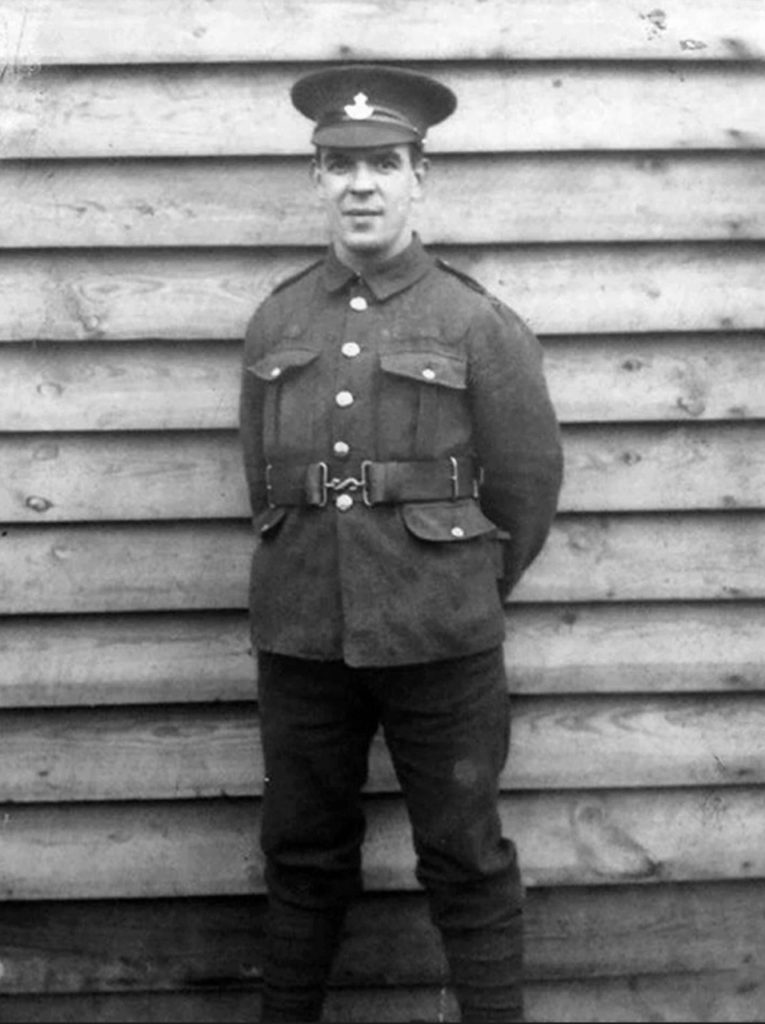
Volunteer John MacDonald, had been fighting in France for 12 months when ‘a small incident’ on the Front resulted in catastrophic consequences.
Lance Corporal John MacDonald was executed for ‘quitting his post’ after retreating 20 yards to a reserve trench while under attack.
There appears to be several historical versions of what took place.
On 26 November 1916, Goggins and MacDonald were guarding a position when Sergeant Joseph Stones, fleeing a German ambush, ran past their position shouting “Run for your lives, the Huns are on top of you!”. Goggins and McDonald retreated to a reserve trench 20 yards (18 m) away. Both men were subsequently charged with deserting their posts, and in spite of Stones’ evidence that he had given the order to retreat, they were convicted at court martial on Christmas Eve and sentenced to death
With Lance Corporal Peter Goggins 21 years, Sergeant Joseph ‘Will’ Stones 23 years and Lance Corporal John MacDonald 28 years, three soldiers from 19th (Bantam) Battalion Durham Light Infantry were blindfolded, manacled, tied to a stake and shot in the woods at a farm at Roëllecourt (a few kilometres away along the railway line) on the 18th January 1917.
The triple execution of the men was carried out to make an example of them.
Haig and his British officers, the orchestrators of the Battle of the Somme, followed by further disasters had just suffered horrific loss of lives on the Somme in one day in July 1916. On the morning of 1st July he had ordered 220,00 British Infantrymen over the top and within a few hours there were almost 60,000 were casualties. 20,000 were dead or dying, many of them lingering for days in no-man’s land. Not an inch of soil was gained.
Five months later by the end of the campaign and the beginning of winter the British had suffered up to 400,000 casualties. Of these 5,500 were Australians.
There was an acknowledged prejudice by officers against the Bantem Brigades. Obviously Haig held no sympathy for ordinary soldiers. Although he did grant a pardon to about half a dozen 19th Durham Light Infantrymen who had followed MacDonald and Goggin out of the dugouts. Their sentence was reduced to 15 years imprisonment.
Haig was a solider whose mind did not keep abreast of changes in warfare. He believed right up 1926 and his death, the value and opportunity for the horse as likely to be as great as ever ‘Aeroplanes and tanks are only accessories to the men and the horse and I feel sure that as time goes on you will find just as much use for the horse—the well-bred horse—as you have ever done in the past!’
Haig had admirers, but rightly so, he had many who criticised his planning and methods as does history, especially for the very high loss off young lives on the battlefields.

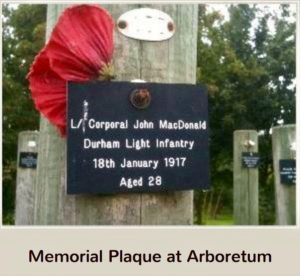
The Shot at Dawn Memorial is a monument at the National Memorial Arboretum near Alrewas, in Staffordshire, UK. It must be the saddest memorial in the world! Please read further.
It commemorates the 309 British Army and Commonwealth (not including Australians) soldiers executed after court martials for desertion and other capital offences during World War 1,a Sculpted concrete figure of a blindfolded soldier with a target hung around his neck. The figure is modelled on Private Herbert Burden who was shot at dawn aged seventeen. 307 wooden stakes are arranged in a semi-circle behind the statue, each bearing a small plaque with the name and service details of those shot at dawn during WW1. The memorial is set within a secluded stand of trees. Benches with individual dedicatory plaques are arranged around the perimeter of the memorial.
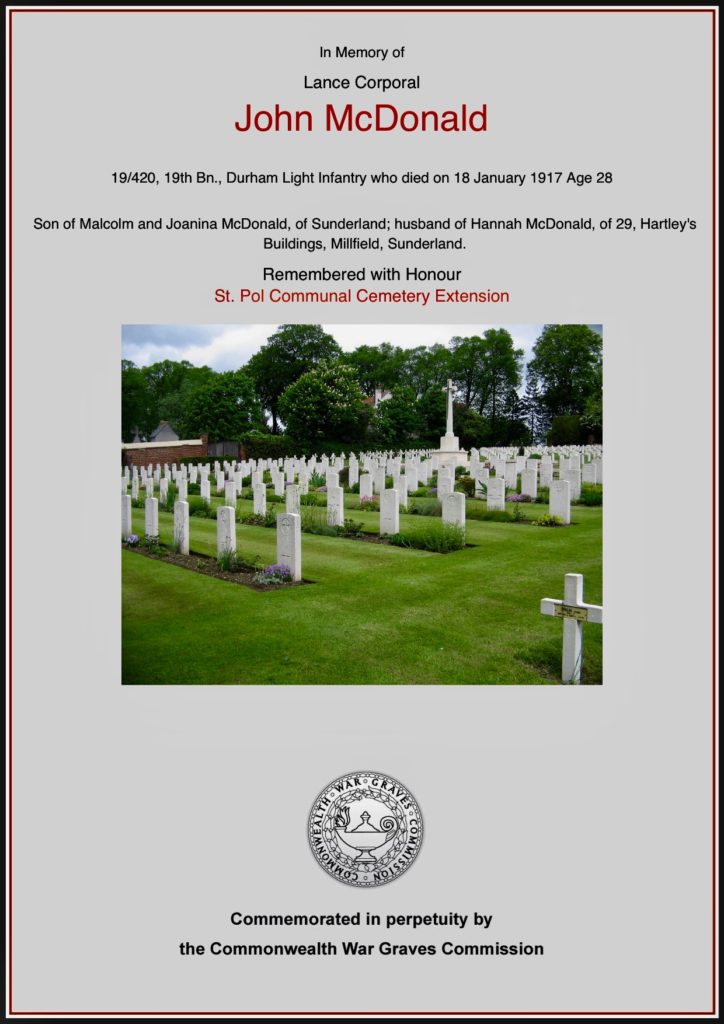

MacDonald Snr’s headstone, France.

MacDonald was sentenced to death by a firing squad with two other soldiers for leaving their post. (further research shows this in fact was not the case-they believed they were about to be overrun by the Germans). In short McDonald and the others were made an example of by the short-sighted British senior army officers who had very little regard for those dying on the front. There is little doubt John MacDonald did anything but desert his post! He was a volunteer, had been fighting in France for 12 months, and hardly likely to run! Although provided legal representation at the sentencing court, it was quite unjust. Even today in 2018, proceedings continue to clear these and other British soldiers of their so-called ‘crime’.
Worse was to follow for the families of these soldiers. It was obviously recorded in the press with deliberate intention by the Army; the men were not awarded any medals, and initially the wives/families were not provided a widow benefit.
The McDonald family had three children! It would have been such a horrid time for the MacDonald family – the loss of husband, father and son not to mention the loss to his siblings. The unimaginable grief followed by the horror of what had brought about his death.
‘About 2am on 26 November 1916, as the Durham Bantams were holding part of the British front line near Arras, Lieutenant James Munday and Sergeant Joseph Stones were attacked by German raiders on the edge of King’s Crater, and Lieutenant Munday was mortally wounded. Sergeant Stones then left his wounded officer and was later stopped behind the front line trenches by military police, who asked him where he was going and what had happened to his rifle. Meanwhile, in the dark and confusion, though the German raiders had not pressed home their attack, other Bantams led by Lance Corporals Peter Goggins and John McDonald abandoned their front line trench. These men were also stopped behind the front line by military police, who found that neither Lance Corporal was carrying a rifle.
On Christmas Eve 1916, Joseph Stones was tried by court martial for “shamefully casting away his arms in the presence of the enemy”, whilst Peter Goggins and John McDonald were tried for leaving their posts without orders from a superior officer. All three were sentenced to death.
An eye-witness account of the executions of Peter Goggins, John MacDonald and Joseph Stones, 18 January 1917, Rollencourt, France.
“Three stakes a few yards apart and a ring of sentries around the woodland to keep the curious away. A moto ambulance arrives conveying the doomed men. Manacled and blindfolded they are helped out and tied up to the stakes. Over each man’s heart is placed an envelope. At the sign of command the firing parties, twelve to each, align their rifles on the envelopes. The officer in charge holds his stick aloft and as it falls thirty-six bullets usher the souls of three Kitchener’s men to the great unknown. As a military prisoner I helped clear up the traces of that triple murder. I took the posts down… I helped carry those bodies towards their last resting place; I collected all the blood-soaked straw and burnt it. Acting on police instructions I took all their belongings from the dead men’s tunics (discarded before being shot). A few letters, a pipe, some fags, a photo. I could tell you of the silence of the military police after reading one letter from a little girl to ‘Dear Daddy’, of the chaplain’s confession that braver men he had never met than those three men he prayed with just before the fatal dawn. I could take you to the graves of the murdered.”
From ‘Shootings at Dawn’ by Ernest Thurtle, Daily Herald,1925.
During the First World War, over 3,000 British soldiers were sentenced to death, though most of these sentences were subsequently commuted to imprisonment, which were then suspended. Seventy of these men were from the DLI. Seven of these DLI soldiers were ‘Shot at Dawn’.
John McDonald was 28 years old.
He was buried at ST. POL COMMUNAL CEMETERY EXTENSION Pas de Calais, France,
Cemetery/memorial reference: D. 3.
For the soldier condemned to execution, his pain ended soon after facing the firing squad at dawn, blindfolded with his hands manacled behind his back, tied to a post.
It was a different matter for the families during the first two years of war. NOK were informed without any regard for the receiver, i.e. in blunt English they were informed ‘the soldier had been executed for ‘acts prejudicial to military discipline’.
One can visualize the terrible scenes at homes when families such as Hannah MacDonald received this news!
We can thank feminist Sylvia Pankhurst and her movement who campaigned strenuously to have this changed!! After this campaign, the authorities sent notice to the families informing them (their executed soldier) ‘died of wounds’ .
Sylvia Pankhurst was a well-known English campaigner for the suffragette movement, her mother was founder of the organisation and Sylvia’s sister was also involved.
Pankhurst was a socialist and later a prominent left communist and later again, an activist in the cause of anti-fascisim.
__________
John (22) and Hannah (21 years) MacDonald (nee Cavanagh) married 28 Dec 1909 at Ryhope. The couple were recorded in England’s 1911 Census residing 20 Wilson Street, Sunderland with eldest son Malcolm 1 year. John worked as Labourer with Greeners Glassworks.
It is believed the execution of MacDonald, Goggins and Stones was made public knowledge (the British government wanted to make the most of the situation) and soon after Hannah was shunned by neighbours.
Hannah MacDonald (nee Cavanagh), with her two sons Malcolm nearly 7 years and John nearly 5, was forced to leave Sunderland and find work as she was also denied a widow’s pension ads punishment for her husband. There were never any medals issued for service for John MacDonald. Hannah left behind her young daughter Florence aged 3 years with her mother-in-law and widow, Johnina MacDonald at Millfield.
Hannah worked at a shipyard owned by Bartram & Sons where she riveted together pieces of metal for war-time ships. Work which was harsh and often resulted in death and injuries. Throughout its history Sunderland has had over 400 registered shipyards starting as early as 1346 with Thomas Menvill’s ship building yard at Hendon.
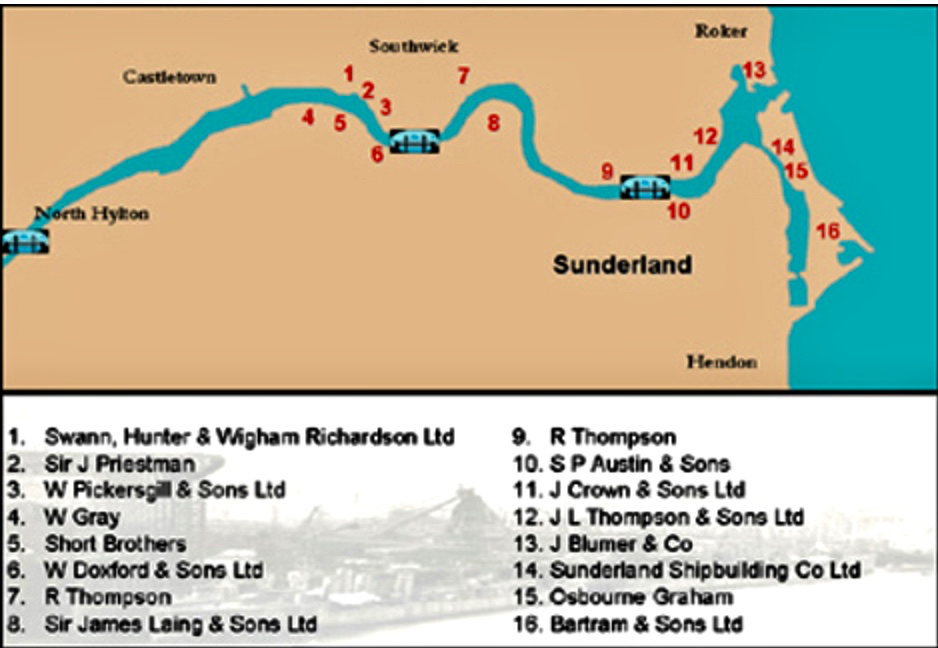
Hannah returned eight years later and the whole family migrated to Western Australia arriving Fremantle on board ‘Ballarat’ 27 May 1928. Hannah had remarried 1917 to Frank Diggle from Chadderton, where they had lived prior to leaving for Australia. Frank Diggie was a former Sapper with Royal Engineers and had sought out Hannah MacDonald as he knew of John MacDonald. Frank and Hannah had two daughters Frances and Violet.
Francis (Frank) Diggle WR314738 was Sapper Royal Engineers Inland Waterways and Docks during WW1.
We don’t know if John and Malcolm knew of their father’s execution. Florence certainly did not.
One of John MacDonald ‘s (Snr) older sisters Elizabeth Ann, married in 1909 to Abraham Worthington (born South Shields in 1885). They emigrated to Western Australia in 1911 and in 1949 Electoral Roll were residing at 364 Newcastle Street, North Perth WA.
Although the death notices suggest John MacDonald Snr’s mother, (she is grandmother to John MacDonald (Jnr)) was living in West Australia – it was his aunt Elizabeth Ann Worthington who placed the notice in the newspaper – probably on behalf of her mother.
The family resided at Forest Grove, Jandakot, and on John’s enlistment details he records his NOK as Hannah Diggie, Jandakot.
In 1942, John’s older brother Malcolm, also living at Jandakot, married Margaret MacRitchie of Northcliiffe. The MacRitchie family settled there with the Government Group Settlement Farming Scheme.

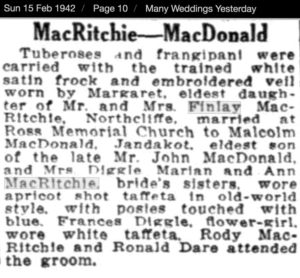
WX37671 Malcolm MacDonald, born 12 March 1910 also enlisted with AIF.
We know Florence married. In Jan 2017 Florence Johnson learnt the truth about her father and for the first time realised the hardship her mother went through. She died 29 January 2018 aged 103 at Willagee, Western Australia.
Frank and Hannah had been working at Hale School and sometime in the early 1940’s they moved to live in Southern Cross.
This is a wonderful historical site – we wish to thank and acknowledge NEMP Researcher James, who has provided much information !
Britain was not alone in executing its own soldiers. The French are thought to have killed about 600. The Germans, whose troops outnumbered the British by two to one, shot 48 of their own men, and the Belgians 13. Italy shot twice as many of their soldiers as Britain.
In 2001, 23 executed Canadians were posthumously honoured by their government, and five troops killed by New Zealand’s military command also recently won a pardon. Not one American or Australian soldier was execute
We weep for the MacDonald family and for the life of John MacDonald who was so keen to enlist and fight for his country, leaving behind his wife and three young children and for his British born second son John MacDonald (Jnr) who enlisted to fight for Australia and lost his life at Singapore 1942.
We wish to thank and acknowledge Gabriella Tsiprou who has provided information about the MacDonald family. For interested family members who would like to make contact with Gabriella:
gtsiprou@hotmail.com

